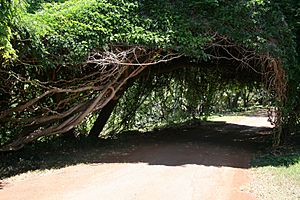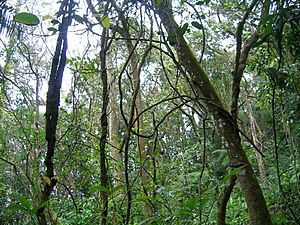Liana facts for kids



A liana is a long-stemmed, woody vine that is rooted in the soil at ground level and uses trees, as well as other means of vertical support, to climb up to the canopy in search of direct sunlight. The word liana does not refer to a taxonomic grouping, but rather a habit of plant growth – much like tree or shrub. It comes from standard French liane, itself from an Antilles French dialect word meaning to sheave.
Ecology
Lianas are characteristic of tropical moist broadleaf forests (especially seasonal forests), but may be found in temperate rainforests and temperate deciduous forests. There are also temperate lianas, for example the members of the Clematis or Vitis (wild grape) genera. Lianas can form bridges amidst the forest canopy, providing arboreal animals with paths across the forest. These bridges can protect weaker trees from strong winds. Lianas compete with forest trees for sunlight, water and nutrients from the soil. Forests without lianas grow 150% more fruit; trees with lianas have twice the probability of dying. Some lianas attain to great length, such as Bauhinia sp. in Surinam which has grown as long as 600 meters. Hawkins has accepted a length of 1.5 km for an Entada phaseoloides. The longest monocot liana is Calamus manan (or Calamus ornatus) at exactly 240 meters.
Lianas may be found in many different plant families. One way of distinguishing lianas from trees and shrubs is based on the stiffness, specifically, the Young's modulus of various parts of the stem. Trees and shrubs have young twigs and smaller branches which are quite flexible and older growth such as trunks and large branches which are stiffer. A liana often has stiff young growths and older, more flexible growth at the base of the stem.
Habitat
Lianas cause damage to trees. They reduce tree growth and reproduction, increase tree mortality, prevent tree seedlings from establishing, alter the course of regeneration in forests.
Althogh lianas provide support for trees when strong winds blow, they may be destructive at times: when one tree falls, the connections made by the lianas may cause many other trees to fall.
Growth rates are lower for trees with lianas as they directly damage hosts, make them more susceptible to ice and wind damage, and increase the probability that the host tree falls. Lianas also make the canopy of trees more accessible to animals which eat leaves, , including ants and many other invertebrates, lizards, rodents, sloths, monkeys, and lemurs. Because of these negative effects, trees which remain free of lianas are at an advantage; some species have evolved characteristics which help them avoid or shed lianas.
Examples
Some families and genera containing liana species include:
- Gnetophyta
- Acanthaceae
- Mendoncia
- Thunbergia, such as T. grandiflora and T. mysorensis
- Anacardiaceae
- Attilaea
- Rhus
- Toxicodendron
- Ancistrocladaceae
- Ancistrocladus
- Annonaceae
- Artabotrys
- Fissistigma
- Uvaria
- Apocynaceae
- Odontadenia
- Stephanotis
- Strophanthus, e.g S. sarmentosus
- Arecaceae
- Calamus
- Daemonorops
- Araceae
- Pothos, e.g. P. lancifolius
- Aristolochiaceae
- Bignoniaceae
- Anemopaegma
- Pyrostegia
- Capparaceae
- Capparis
- Celastraceae
- Celastrus
- Connaraceae
- Connarus
- Dilleniaceae
- Doliocarpus
- Dioscoreaceae
- Dioscorea, e.g. D. sylvatica
- Fabaceae
- Flagellariaceae
- Flagellaria indica
- Loganiaceae
- Strychnos, e.g. S. axillaris
- Nepenthaceae
- Nyctaginaceae
- Oleaceae
- Jasminum
- Polygalaceae
- Moutabea, e.g. M. Aculeata
- Rosaceae
- Rosa banksiae
- Sapindaceae
- Paullinia
- Rhamnaceae
- Ventilago
- Ziziphus
- Rubiaceae
- Uncaria
- Rutaceae
- Toddalia asiatica
- Schlegeliaceae
- Schlegelia
- Smilacaceae
- Verbenaceae
- Petrea, e.g. P. volubilis
- Vitaceae
- Ampelopsis
- Cissus, e.g. C. hypoglauca
- Parthenocissus
- Tetrastigma
- Vitis
See also
 In Spanish: Liana (trepadora) para niños
In Spanish: Liana (trepadora) para niños


